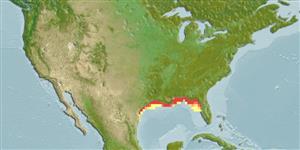>
Clupeiformes (Herrings) >
Alosidae (Shads and Sardines)
Etymology: Alosa: Latin, alausa = a fish cited by Ausonius and Latin, halec = pickle, dealing with the Greek word hals = salt; it is also the old Saxon name for shad = "alli" ; 1591 (Ref. 45335); chrysochloris: From the words chryso, meaning gold and chloris, meaning green (Ref. 10294).
More on author: Rafinesque.
Environment: milieu / climate zone / εύρος βάθους / distribution range
Οικολογία
Θαλασσινό(ά); Γλυκού νερού; Υφάλμυρο pelagic-neritic; ανάδρομο (Ref. 51243). Subtropical; 45°N - 23°N, 100°W - 82°W (Ref. 188)
Western Central Atlantic: Gulf of Mexico (from Corpus Christi in Texas eastward to Pensacola in Florida; also in rivers, e.g. Mississippi and Ohio Rivers to Minnesota, Wisconsin and Pennsylvania).
Μέγεθος / Βάρος / Age
Γεννητική Ωρίμανση: Lm ? range ? - ? cm
Max length : 50.0 cm SL αρσενικό/απροσδιόριστο; (Ref. 188); common length : 37.5 cm SL αρσενικό/απροσδιόριστο; (Ref. 188); μεγ. δημοσιευμένο βάρος: 1.7 kg (Ref. 4699); μεγ. αναφερόμενη ηλικία: 4 έτη (Ref. 12193)
Ραχιαίες άκανθες (συνολικά) : 0; Εδρικές άκανθες: 0. Belly with a distinct keel of scutes. Lower jaw not rising steeply within mouth; teeth prominent at front of lower jaw. Lower gill rakers slender. Back bluish green, abruptly changing to silver on flank; no dark spot at shoulder. Closely resembles A. mediocris of Atlantic coasts, which has no upper and weak lower jaw teeth, a dark shoulder spot and the body deeper than head length (Ref. 188).
Body shape (shape guide): fusiform / normal; Cross section: compressed.
Generally present in coastal marine water (Ref. 37039). Enter brackish- and freshwaters, but perhaps not always or not consistently anadromous (Ref. 188), although strongly migratory within rivers (Ref. 10294) , mostly in fast-flowing water where they are renowned for leaping. Feed on small fishes, the juveniles on insects. Spawning times and places not certain. Adults serve as hosts to the larvae (glochidia) of the economically valuable pearly mussel (Fusconaia ebena) of the Mississippi basin (Ref. 188).
Life cycle and mating behavior
Γεννητική Ωρίμανση | Αναπαραγωγή | Γεννοβολία | Αβγά | Γονιμότητα | Προνύμφες
Whitehead, P.J.P., 1985. FAO Species Catalogue. Vol. 7. Clupeoid fishes of the world (suborder Clupeoidei). An annotated and illustrated catalogue of the herrings, sardines, pilchards, sprats, shads, anchovies and wolf-herrings. FAO Fish. Synop. 125(7/1):1-303. Rome: FAO. (Ref. 188)
IUCN Red List Status (Ref. 130435: Version 2025-1)
Threat to humans
Harmless
Human uses
αλιεία: περιορισμένης εμπορικότητας; αλιεία αναψυχής: ναί
Εργαλεία
Special reports
Download XML
Διαδικτυακές πηγές
Estimates based on models
Preferred temperature (Αναφ.
123201): 23.1 - 24.6, mean 23.9 °C (based on 126 cells).
Phylogenetic diversity index (Αναφ.
82804): PD
50 = 0.5000 [Uniqueness, from 0.5 = low to 2.0 = high].
Bayesian length-weight: a=0.00589 (0.00344 - 0.01007), b=3.03 (2.89 - 3.17), in cm total length, based on LWR estimates for this species & Genus-body shape (Ref.
93245).
Τροφικό Επίπεδο (Αναφ.
69278): 3.9 ±0.63 se; based on food items.
Ελαστικότητα (Αναφ.
120179): Μεσαίο(α), ελάχιστος χρόνος για διπλασιασμό πληθυσμού 1,4 - 4,4 έτη (tmax=4).
Fishing Vulnerability (Ref.
59153): Moderate vulnerability (44 of 100).
🛈
